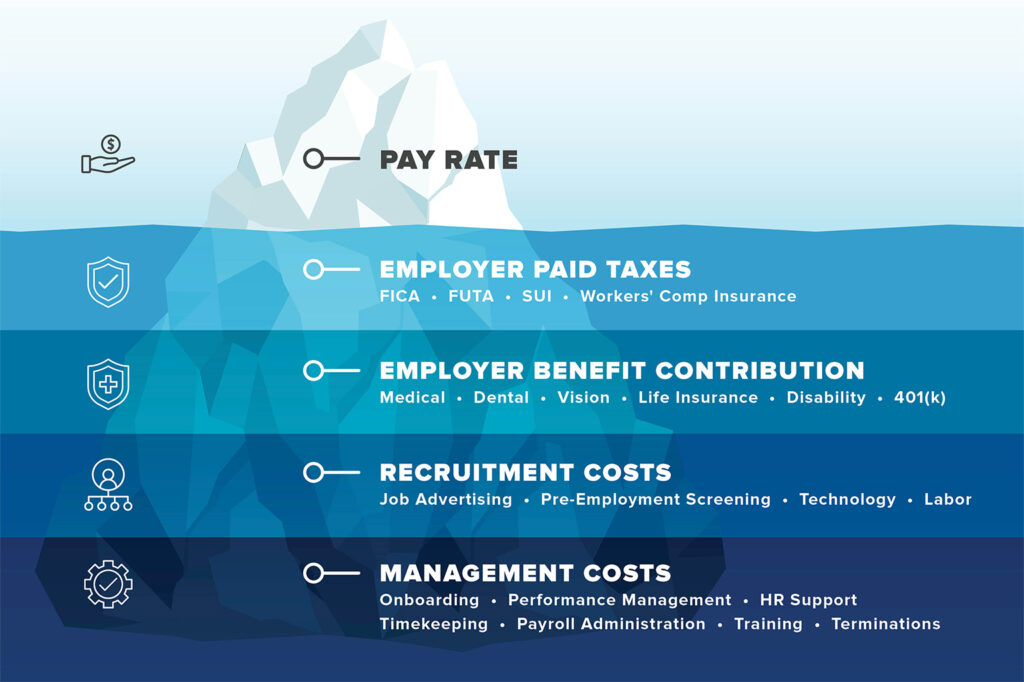
The Tip of the Iceberg
What you need to know about the hidden costs of hiring
By Jim Blythe, InnoSource Vice President
Hiring new employees is an intricate and expensive process for companies — and those costs go above and beyond just paying salaries or hourly wages. Hiring managers, naturally, often focus solely on filling open roles with great talent to accomplish their team’s goals. The costs of hiring that live below the surface are out-of-sight, out-of-mind for those managers — and of course they are.
But the complete financial picture of hiring goes beyond allocating resources for an individual’s salary. Many hiring managers don’t initially consider these hidden costs, because their jobs require them to be focused on the day-to-day. At an organizational level, though, hidden costs can cause significant issues for companies’ bottom lines, especially when we’re talking about multiple hires. Understanding hidden costs can help businesses plan and budget more effectively.
Before joining InnoSource, I wouldn’t have considered these costs, either. But now that I know about them, I want to share them with you. So, let’s consider some of the costs that lie hidden below the surface, starting with the immediate.
To start, consider payroll taxes. In the U.S., employers pay a U.S. federal payroll tax called FICA, comprised of Social Security and Medicare taxes at a rate of 7.65% for every dollar in salary paid to an employee. In addition, employers pay both federal and state unemployment taxes, too. The Federal Unemployment Tax Act rate is 0.6% on the first $7,000 of wages per employee each year. State unemployment rates vary widely, often ranging from 1% to over 6%, depending on the employer’s history and state regulations.
Employers also pay workers’ compensation insurance, which covers medical costs and lost wages for employees injured on the job. Premiums vary based on industry risk levels and the company’s claim history, but the National Academy of Social Insurance notes that the average cost is about $1.32 per $100 of covered wages.
And costs accelerate once you hire a new employee, starting with benefits and insurance. Employers typically cover a portion of health insurance premiums, life insurance, disability insurance and retirement plan contributions. Employers pay an average of $6,435 annually for single coverage health insurance per employee, per the Kaiser Family Foundation. These benefits are essential for attracting and retaining talent, but they represent a significant financial commitment.
In-house recruitment costs also can be substantial. According to the Society for Human Resource Management, the average cost per hire is around $4,700. This figure includes advertising job openings, using recruiting software and the time HR personnel invest in the process. Once a candidate is hired, they have to be onboarded. Glassdoor has run some numbers and estimates that effective onboarding, including orientation, training, and staff time to mentor new employees costs about $4,000 per hire. These efforts are crucial for getting new employees up to speed and ensuring their productivity, but they increase the cost to bring an employee on — meaning each hire needs to be a long-term solution to maximize those investments.
All these costs add up, making the true expense of hiring much more than just salaries. For businesses, this highlights the importance of strategic planning and efficient recruitment practices. And, if I might toot our horn a bit, it is one reason to consider partnering with a firm like InnoSource. In many cases, we take on those hidden costs up front through our contract staffing and other services, saving our clients money in the short and long run. Of course, I’d be glad to talk about that with you at any time. But even if we don’t connect, please consider the hidden costs of hiring as you budget for HR expenses. Doing so will make you a more strategic and effective player in your organization.

